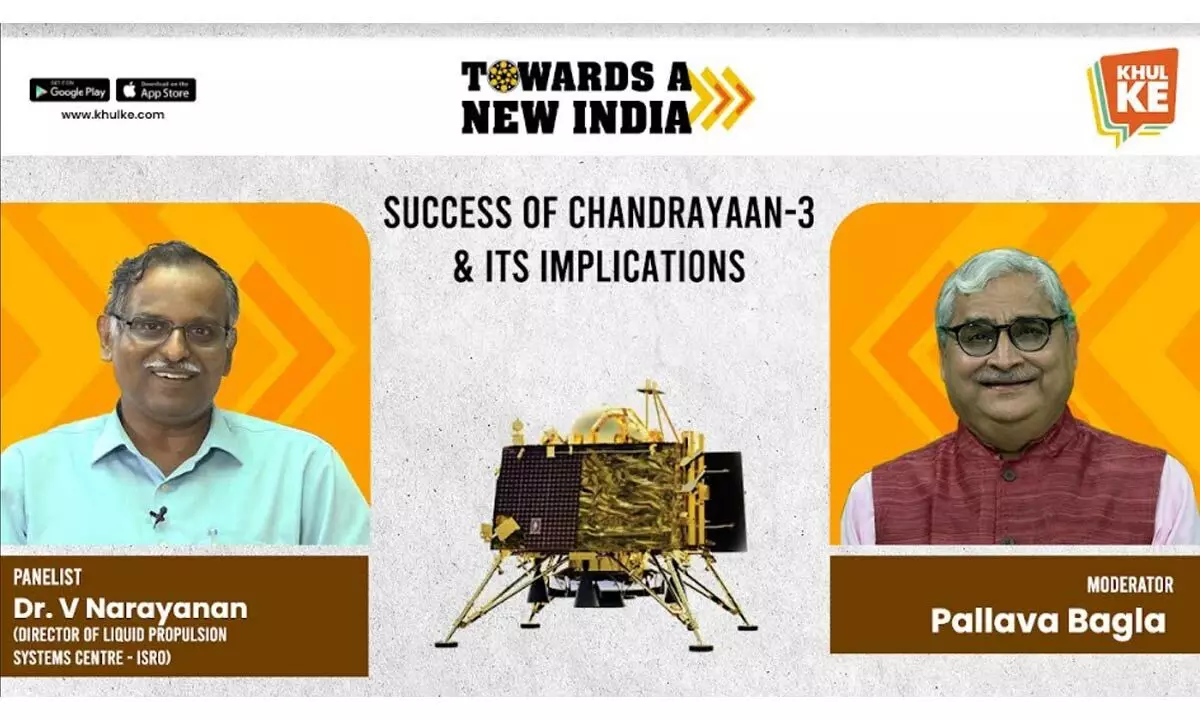Chandrayaan-3, this dialogue delves into uncharted territories. Unlocking India's Space Exploration Vision: Chandrayaan-3's Triumph and more unveiled by Khul Ke

On 23rd August, ISRO successfully transformed what was once considered the harrowing "20 minutes of terror" into a resounding "20 minutes of joy”, and the credit for that goes to the esteemed Dr. V. Narayanan, the Director of the Liquid Propulsion Systems Centre at the Indian Space Research Organisation (ISRO).
On 23rd August, ISRO successfully transformed what was once considered the harrowing "20 minutes of terror" into a resounding "20 minutes of joy”, and the credit for that goes to the esteemed Dr. V. Narayanan, the Director of the Liquid Propulsion Systems Centre at the Indian Space Research Organisation (ISRO). Dr. Narayanan played a pivotal role in orchestrating the triumphant soft landing of Chandrayaan-3 on the lunar surface.
Khul Ke continues its unwavering commitment to stimulating engaging discussions within the realm of social networking apps. Moderator Pallava Bagla had the opportunity to sit down with the man himself in his most recent RoundTable discussion.
Prior to steering the ship towards this remarkable achievement, Dr. Narayanan held the prestigious position of Chairman of the national-level Failure Analysis Committee for Chandrayaan-2. His unwavering dedication to dissecting the mission's challenges were instrumental in identifying the root causes of its setbacks.
Speaking on the scientific objectives of the lander and rovers, Dr. Narayanan explained, “We had six scientific payloads to this mission...we have found important minerals like manganese, calcium, sulphur, titanium, chromium, oxygen and eight minerals. The lander and rovers are also equipped with a special instrument for Lunar Seismic Activity, which will detect and study lunar quakes. Another payload is Chandra’s surface Thermo-Physical Experiment (ChaSTE), where we basically want to understand the temperature history of the moon’s surface…Another probe called the RAMBHA and Langmuir probe will conduct experiments to study plasma activities on the moon…Another will obtain real-time distance measurements between the moon and the earth to understand the moon’s orbital behaviour better… So, it’s not just about the achievement of the sharp landing we have to celebrate, but all the scientific payloads we’ll be getting out of this mission.”
ISRO also exceeded their mission objectives with Chandrayaan-3 when near the end of its 14 days, it performed a Hop test successfully and skillfully soft-landed on the moon twice. This test can help determine the capability of ISRO to carry out missions where the rovers would return with samples as well as future manned missions. Dr. Narayanan recounts the experience for Khul Ke, “We had successfully landed and then the rover came out and was moved almost 100 meters. We began thinking if we could carry out the Hop test. In the future when we land on the moon, our objective will not just be about soft landing but also about being able to return to earth with samples for testing as well. To do all of these things, we decided to lift the lander … in fact it was 4 am in the morning and the chairman of ISRO himself was there with us when the decision was made. We authorised the operation of two of the engines for the Hop…and then finally it was lifted over 40 cm above the surface of the moon. This data is going to be highly valuable, not just for ISRO but the world. This was an excellent experiment that was beyond the scope of the original mission. We tried to maximise as much utility out of the mission.”
On why ISRO decided to schedule the Aditya L1 Probe to study the Sun, so close to the Chandrayaan-3 missions, Dr. V. Narayanan said, “At ISRO, we had been planning to send a probe to the Sun for 7-8 years now. In the entire world, only 3 countries other than India have gone and studied the Sun. Like Chandrayaan-3, it’s a very beautiful baby project for everyone at ISRO. For Aditya too, we have to ensure a functional propulsion system and the same engine that took Chandrayaan to the moon has been used for Aditya’s systems as well…This mission too will help us gather extensive data and will once more be an accomplishment worthy of immense pride for us Indians.”
Khul Ke has highlighted some of the most pertinent conversations around the Indian space scene by providing a glimpse into the daunting challenges that ISRO has overcome and continues to confront in its relentless pursuit of scientific exploration. On 22nd of September, the eve of the lunar sunrise, both the Vikram lander and Pragyan rover are expected to (hopefully) wake up. While we await the start of another new dawn there’s no denying that ISRO's incredible journey has become a testament to the power of hard work and paying attention to detail.

















